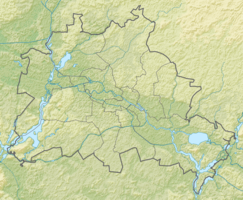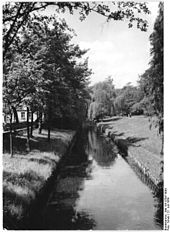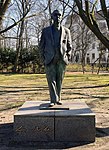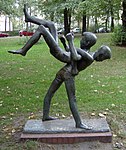Bürgerpark Pankow
| Bürgerpark Pankow | ||
|---|---|---|
| Park in Berlin | ||

|
||
| The entrance gate of the Bürgerpark | ||
| Basic data | ||
| place | Berlin | |
| District | Pankow | |
| Created | 1864 (private) | |
| Newly designed | 1907 for the public | |
| use | ||
| User groups | Foot traffic ; Leisure , events | |
| Technical specifications | ||
| Parking area | 120,000 m² | |
|
52 ° 34 '10 " N , 13 ° 23' 35" E
|
||
The Bürgerpark Pankow is a twelve- hectare park along the Panke in Berlin . It was converted into a country house in the 19th century and acquired by the Pankow community in 1907 . The publicly accessible green area is located in the immediate vicinity of the Pankow town hall in the Pankow district . It borders the villas around Heinrich-Mann-Platz in the east, the Pankow III cemetery in the north, the railway area of Berlin Wollankstrasse station in the west and Wilhelm-Kuhr-Strasse in the south.
history
prehistory
In 1856, the founder of the Berliner Börsen-Zeitung , Hermann Killisch von Horn , acquired the area of today's Bürgerpark on the Panke, a former paper mill from 1800, in order to set up a country estate for himself and his family. In the years 1863–1864 he enlarged the area to ten hectares by purchasing it and, together with Wilhelm Perring (1838–1907), who later became the garden inspector and technical director of the Berlin Botanical Garden , created a landscape garden based on the English model .
The building of the old paper mill, which once employed up to 60 workers, was converted into a mansion, residential, commercial and jewelry buildings were built, palm houses, bridges and an Indian temple . The entrance was the still existing three-part entrance portal in the neo-renaissance style , built around 1865 on the model of Italian triumphal arches and completely restored in 2007 . After the founder's death, the park initially remained in family ownership. The Hermann Killisch von Horns mausoleum is located on the First Community Cemetery, which was then located by the park , which today has the character of a park as a decorative cemetery and was added to the Bürgerpark.
History of origin
In 1907 the municipality of Pankow bought the park under its mayor Wilhelm Kuhr (1865-1914) for 1.45 million marks (adjusted for purchasing power in today's currency: around 8.83 million euros). Wilhelm Kuhr advocated the acquisition of the site and thus prevented the park from falling victim to soil speculation that existed in the up-and-coming Berlin suburbs during the early days .
The head gardener's house was converted into a garden restaurant with a music pavilion, and the park was converted into a public green area. When the park was opened to the public in 1907, it was given its current name. In 1923 the Volkspark Schönholzer Heide was created on the north bank of the Panke in the Niederschönhauser area . Organizationally, it belonged to the park on the other side of Hermann-Hesse-Strasse. This strip was run under its own name until the 1990s, although it evidently formed a unit with the Bürgerpark and the 1st municipal cemetery on Wilhelm-Kuhr-Strasse at the corner of Kreuzstrasse, which was closed in 1971. For a few years, the Bürgerpark was even advertised as a spa park by an enterprising pharmacist , because he successfully ran a bar with the most famous mineral waters in Germany and Europe right in the middle.
The buildings in the park were badly affected by the air raids in the Second World War and were then dismantled and partly demolished in the 1960s. This affected the manor house and the restaurant building. After a fundamental renovation between 1965 and 1968, the park was given its current appearance. The Panke characterizes the park as well as spacious meadows and an extensive, well-preserved tree population. In the south of the park between two man-made hills there has been an animal enclosure since the 1950s, which has been occupied by dwarf goats since the 1990s . Aviaries with peacocks , pheasants and rare pigeons can be found at the former hunter's house.
In the summer months, visitors can use the park library , the café is open all year round and the rose garden area invites you to linger.
Abundance of plants
The trees, some of which are up to 150 years old, consist of oaks , beeches and many types of maple . An approximately hundred-year-old bald cypress (Taxodium distichum) stands as a natural monument along the banks of the Panke . Other designated natural monuments are an American red oak (Quercus rubra) and a common beech (Fagus sylvatica) . During a visit to the park, you can discover the mulberry tree , trumpet tree , tulip tree and sweet chestnut .
In the years 1990–1992 a varietal rose garden was created, which is an attraction for the visitors in summer. Bed and shrub roses, tea hybrids, mini roses, trunks and climbing roses that creep up the pergola made of sandstone columns bloom here. Concerts are occasionally held in the music pavilion .
Playground, park design and Panke hiking trail
On the western edge of the Bürgerpark there is a playground with a large climbing ship north of the Panke in Volkspark Schönholzer Heide. Directly to the south-west of this was the Berlin Wall with the Kolonnenweg until 1990 . You can now visit the “Pinke Panke” children's farm there. Near the east entrance there has been a four meter high fountain in a walled 10 meter basin since 1968. In the 1970s there was a small library , an animal enclosure and an open-air restaurant in the park .
The footpath along the Panke has been continuously expanded since the late 1990s. Part of it leads directly through the Bürgerpark.
Art in the park
Over the years, sculptures and monuments have been erected at various points in the park , mostly on behalf of the public sector . In chronological order these are:
- (Selection)
- 1951: bust for Heinrich Mann , created by Gustav Seitz ,
- 1958: Gazelle , 1958, by Walter Sutkowski ,
- 1960: Johannes R. Becher , by Fritz Cremer ,
- 1965: Gymnastics Boys , by Gerhard Rommel ; stolen in 2011,
- 1971: Upright Figure No. 9 , by René Graetz ,
- 1973: Monument to Julius Fučik ,
honoring the Czech writer and resistance fighter. It is at the northeast exit of the Volkspark. The words carved in stone there “People, I loved you, be vigilant!” Are taken from his report written under the strand . The monumental complex was created by the Czech sculptor Zdeněk Němeček as a gift from the ČSSR for the Xth World Festival in 1973 in Berlin . - 1987: Vegetative Landscape , by Friedrich B. Henkel,
- 1989: Resting Man , by Sabine Teubner-Mbaye ,
- 1989: Standing girl , by Sabine Teubner-Mbaye,
- 2006: Long bench , by Susanne Specht , colored concrete.
Transport links
The Bürgerpark can be reached from the Wollankstraße S-Bahn station or the Pankow S- / U-Bahnhof . With the tram line M1 and the buses of the lines 155 and 250 to the stop Pankow it also enters the park. The bus line 255 stops at the Wilhelm-Kuhr-Straße station , which leads exactly to the main entrance. The Panke bike and hiking trail leads through the park along the Panke. In addition, the Berlin Wall Trail runs along the southwest edge of the Bürgerpark.
literature
- Astrid von Killisch-Horn: Bürgerpark Pankow - Green living space in times of change . Rudolstadt, 2007, ISBN 978-3-00-021923-8 .
- Ralph Hoppe: Bolle recently traveled ... (Pankow in the course of history). be.bra Verlag GmbH Berlin-Brandenburg 1998, p. 52 ff.
- Rudolph Dörrier: Pankow (reprint of the Small Chronicle of a Berlin District 1949), Panko-Press 2000, p. 65.
Web links
- Entry in the Berlin State Monument List with further information
- www.buergerpark-pankow.de
- The green place Pankow (Bürgerpark)
Individual evidence
- ^ Plan of Berlin. Sheet 4336 and 433B ( Memento from November 9, 2015 in the Internet Archive )
- ^ Hans Prang, Horst Günther Kleinschmidt: Through Berlin on foot . Tourist-Verlag, Berlin / Leipzig 1983. p. 226 ff.
- ↑ Homepage Bildhauerei-in-Berlin.de with information on the art monuments in the Pankower Bürgerpark ( Memento from March 27, 2010 in the Internet Archive )
- ↑ Upright Figure No. 9 ( Memento from October 4, 2013 in the Internet Archive )
- ↑ Lange Bank ( Memento from October 4, 2013 in the Internet Archive )









